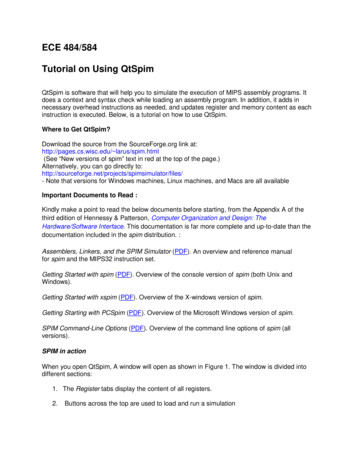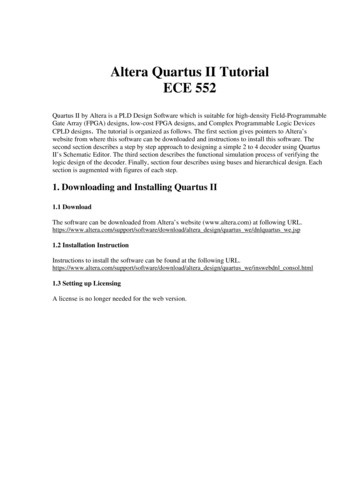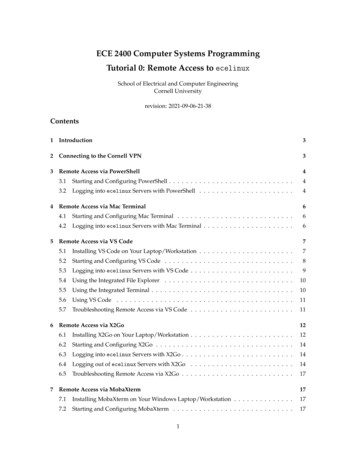
Transcription
ECE 484/584Tutorial on Using QtSpimQtSpim is software that will help you to simulate the execution of MIPS assembly programs. Itdoes a context and syntax check while loading an assembly program. In addition, it adds innecessary overhead instructions as needed, and updates register and memory content as eachinstruction is executed. Below, is a tutorial on how to use QtSpim.Where to Get QtSpim?Download the source from the SourceForge.org link at:http://pages.cs.wisc.edu/ larus/spim.html(See “New versions of spim” text in red at the top of the page.)Alternatively, you can go directly iles/- Note that versions for Windows machines, Linux machines, and Macs are all availableImportant Documents to Read :Kindly make a point to read the below documents before starting, from the Appendix A of thethird edition of Hennessy & Patterson, Computer Organization and Design: TheHardware/Software Interface. This documentation is far more complete and up-to-date than thedocumentation included in the spim distribution. :Assemblers, Linkers, and the SPIM Simulator (PDF). An overview and reference manualfor spim and the MIPS32 instruction set.Getting Started with spim (PDF). Overview of the console version of spim (both Unix andWindows).Getting Started with xspim (PDF). Overview of the X-windows version of spim.Getting Starting with PCSpim (PDF). Overview of the Microsoft Windows version of spim.SPIM Command-Line Options (PDF). Overview of the command line options of spim (allversions).SPIM in actionWhen you open QtSpim, A window will open as shown in Figure 1. The window is divided intodifferent sections:1. The Register tabs display the content of all registers.2.Buttons across the top are used to load and run a simulation
3. The Text tab displays the MIPS instructions loaded into memory to be executed.(From left-to-right, the memory address of an instruction, the contents of the addressin hex, the actual MIPS instructions – where register numbers are used, the MIPSassembly that you wrote, and any comments you made in your code are displayed.)4. The Data tab displays memory addresses and their values in the data and stacksegments of the memory.5. The Information Console lists the actions performed by the simulator.Figure 1 : QtSpimTo run the program in QtSpim:1. Use a text editor to create your program yyyyyy.s2. Click on the “load” button and open yyyyyy.s3. You can then run the program by simply pressing the “run” (play) button – all instructions willbe executed, and the final contents of memory and the register file will be reflected in theQtSpim window.
DebuggingSuppose your program does not do what you expect. What can you do? QtSpimhas two features that help debug your program.The first, and perhaps the most useful, is single-stepping, which allows you to run your programan instruction at a time. The single stepping icon can be found in the toolbar. Every time youdo single stepping, QtSpim will execute one instruction and update its display, so that youcan see what the instruction changed in the registers or memory.What do you do if your program runs for a long time before the bug arises? You could singlestep until you get to the bug, but that can take a long time. A better alternative is to use abreakpoint , which tells QtSpim to stop your program immediately before it executes a particularinstruction. When QtSpim is about to execute the instruction where there is a breakpoint, it asksfor continue, single stepping or abort.Single-stepping and setting breakpoints will probably help you find a bug in your programquickly. How do you fix it? Go back to the editor that you used to create your program andchange it. Click on the Riinitialize simulator tab in the toolsbar and load the sourcefile again.Generally Useful InformationWhen using QtSpim, you may find the following information to be useful:You can access all of the commands via the “File” and “Simulator” menus as well.When examining register or memory data, you can view the data in binary, hex, or decimalformat. Just use the “Register” pull down menu to select.Kernel Text and Kernel Data may not be necessary to be viewed all the times, you can unselectthem by unselecting “Kernel Text” in the “Text Segment” pull down menu and unselecting“Kernel Data” in the “Data Segment” pull down menu.You can set breakpoints in your code simply by right clicking on an instruction in the Text tab.To view memory data, simply click on the Data tab.By right clicking on a register file value or memory address value, you can change its contentsdynamically.Example ProgramBelow is an example program to find the sum of an array. Copy this into a text editor and save itas a .s file and open it in QtSpim by loading the file. You can directly run it or do single steppingand observe the change in the Register file. At the end of the Program you should be able tosee the result stored in S1 as “1e” (2 4 6 8 10 30 0x1e) and the console will print thisresult. The code is well commented which should help you start straight away.,
# first SPIM program# ECE 484/584#.data# Put Global Data hereN: .word 5# loop countX: .word 2,4,6,8,10# array of numbers to be added'SUM: .word 0# location of the final sumstr:.asciiz "The sum of the array is ".text# Put program here.globl main# globally define 'main'main: lw s0, N# load loop counter into s0la t0, X# load the address of X into t0and s1, s1, zero# clear s1 aka temp sumloop: lw t1, 0( t0)# load the next value of xadd s1, s1, t1# add it to the running sumaddi t0, t0, 4# increment to the next addressaddi s0, s0, -1# decrement the loop counterbne 0, s0, loop# loop back until completesw s1, SUM# store the final totalli v0, 10# syscall to exit cleanly from main only, refer to Figure# A.9.1 in the Assemblers, Linkers, and the SPIM#Simulator document (PDF).syscall# this ends execution.end
Steps:1. Load the program2. Execute
3. Observe the change in Register contents
PDF). An overview and reference manual for . spim. and the MIPS32 instruction set. Getting Started with spim (PDF). Overview of the console version of . spim (both Unix and Windows). Getting Started with xspim (PDF). Overview of the X-windows version of . spim. Getting Starting with PCSpim (PDF). Overview of the Microsoft Windows version of . spim.










